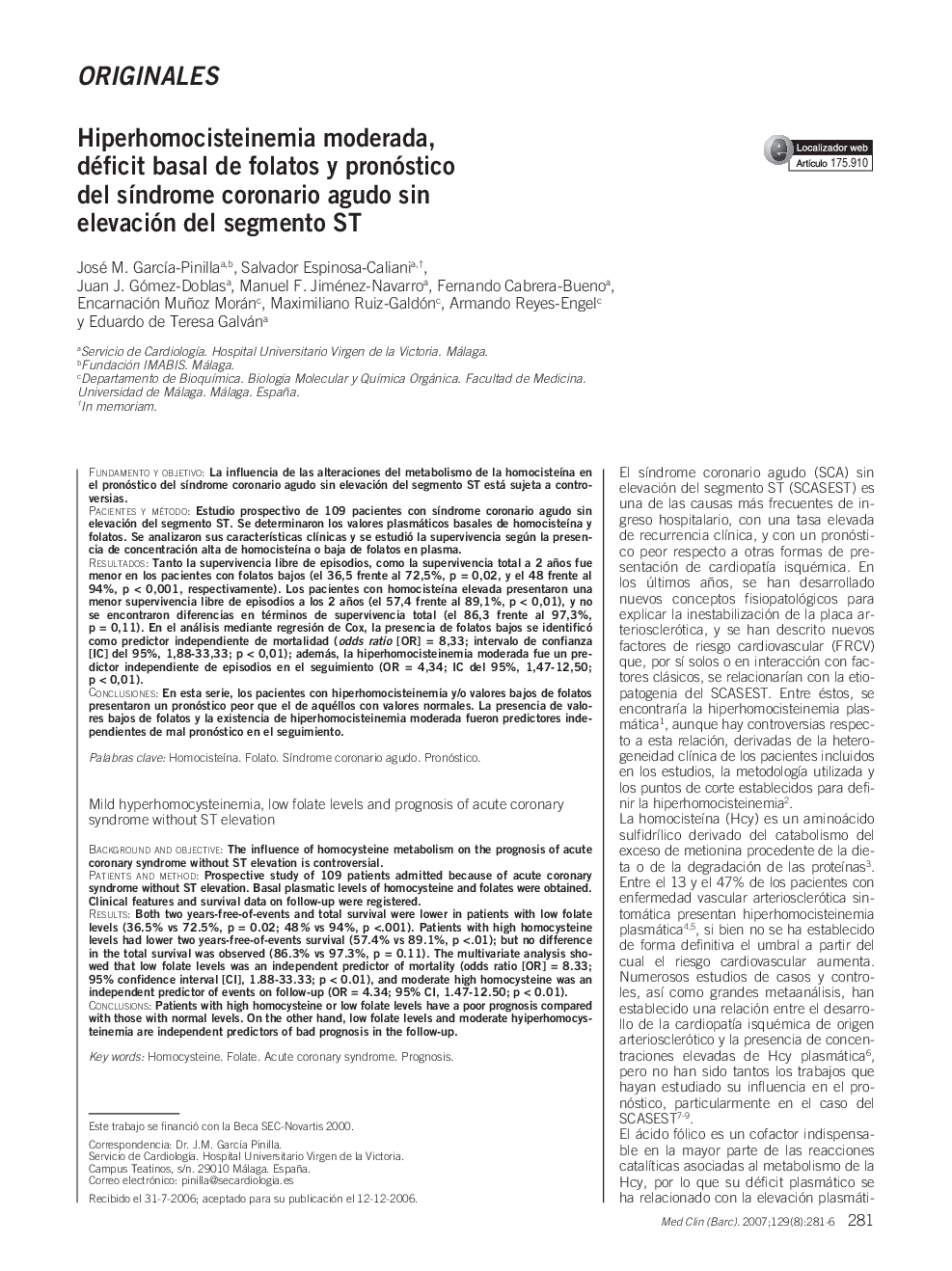| Article ID | Journal | Published Year | Pages | File Type |
|---|---|---|---|---|
| 3803550 | Medicina Clínica | 2007 | 6 Pages |
Fundamento y objetivoLa influencia de las alteraciones del metabolismo de la homocisteÃna en el pronóstico del sÃndrome coronario agudo sin elevación del segmento ST está sujeta a controversias.Pacientes y métodoEstudio prospectivo de 109 pacientes con sÃndrome coronario agudo sin elevación del segmento ST. Se determinaron los valores plasmáticos basales de homocisteÃna y folatos. Se analizaron sus caracterÃsticas clÃnicas y se estudió la supervivencia según la presencia de concentración alta de homocisteÃna o baja de folatos en plasma.ResultadosTanto la supervivencia libre de episodios, como la supervivencia total a 2 años fue menor en los pacientes con folatos bajos (el 36,5 frente al 72,5%, p = 0,02, y el 48 frente al 94%, p < 0,001, respectivamente). Los pacientes con homocisteÃna elevada presentaron una menor supervivencia libre de episodios a los 2 años (el 57,4 frente al 89,1%, p < 0,01), y no se encontraron diferencias en términos de supervivencia total (el 86,3 frente al 97,3%,p = 0,11). En el análisis mediante regresión de Cox, la presencia de folatos bajos se identificó como predictor independiente de mortalidad (odds ratio [OR] = 8,33; intervalo de confianza [IC] del 95%, 1,88-33,33; p < 0,01); además, la hiperhomocisteinemia moderada fue un predictor independiente de episodios en el seguimiento (OR = 4,34; IC del 95%, 1,47-12,50;p < 0,01).ConclusionesEn esta serie, los pacientes con hiperhomocisteinemia y/o valores bajos de folatos presentaron un pronóstico peor que el de aquéllos con valores normales. La presencia de valores bajos de folatos y la existencia de hiperhomocisteinemia moderada fueron predictores independientes de mal pronóstico en el seguimiento.
Background and objectiveThe influence of homocysteine metabolism on the prognosis of acute coronary syndrome without ST elevation is controversial.Patients and methodProspective study of 109 patients admitted because of acute coronary syndrome without ST elevation. Basal plasmatic levels of homocysteine and folates were obtained.Clinical features and survival data on follow-up were registered.ResultsBoth two years-free-of-events and total survival were lower in patients with low folate levels (36.5% vs 72.5%, p = 0.02; 48% vs 94%, p <.001). Patients with high homocysteine levels had lower two years-free-of-events survival (57.4% vs 89.1%, p <.01); but no difference in the total survival was observed (86.3% vs 97.3%, p = 0.11). The multivariate analysis showed that low folate levels was an independent predictor of mortality (odds ratio [OR] = 8.33;95% confidence interval [CI], 1.88-33.33; p < 0.01), and moderate high homocysteine was an independent predictor of events on follow-up (OR = 4.34; 95% CI, 1.47-12.50; p < 0.01).ConclusionsPatients with high homocysteine or low folate levels have a poor prognosis compared with those with normal levels. On the other hand, low folate levels and moderate hyiperhomocysteinemia are independent predictors of bad prognosis in the follow-up.
